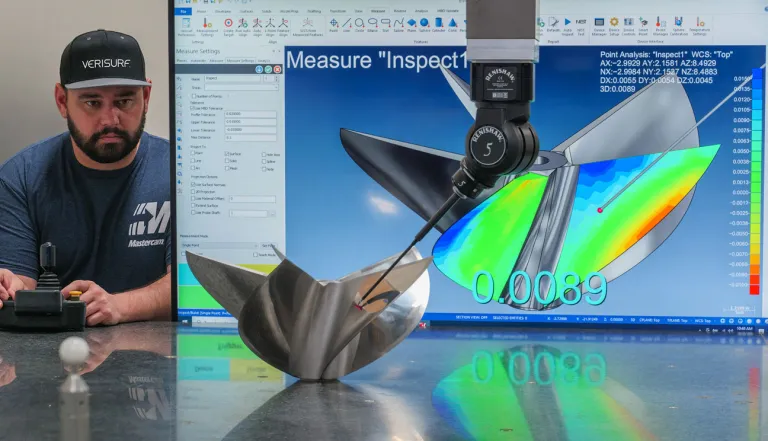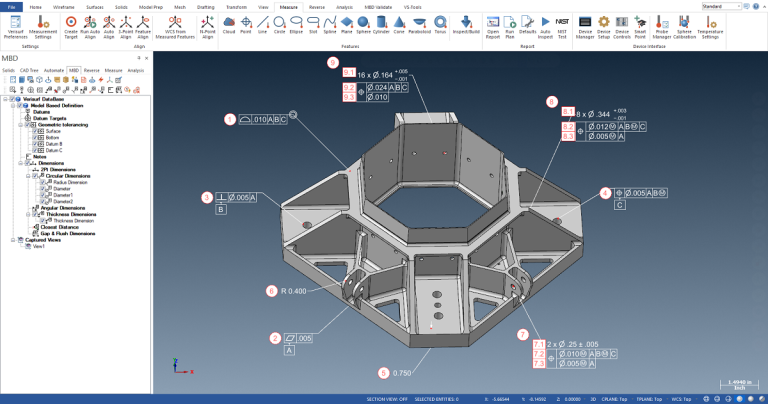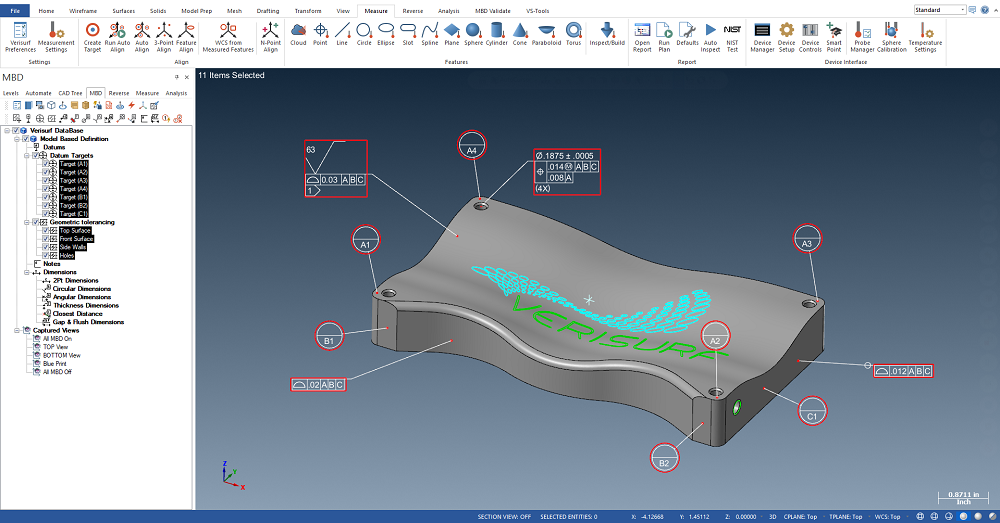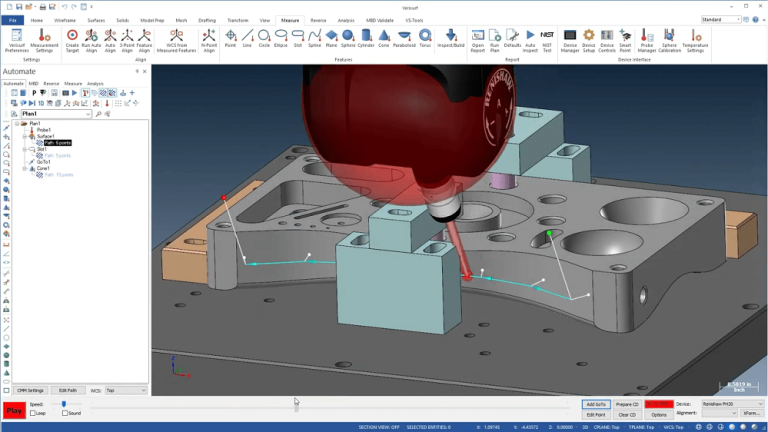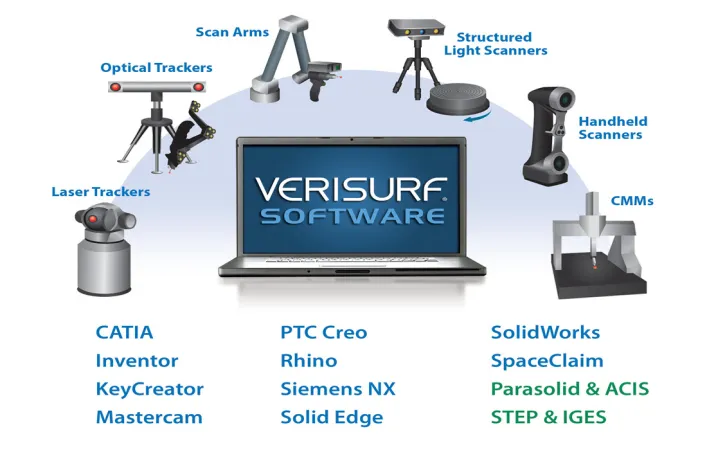‘No Code’ Programming – Advancing CMM Productivity
In the realm of precision manufacturing and quality control, Coordinate Measuring Machines (CMMs) play a crucial role in ensuring component dimensional accuracy. Recent advancements in CAD-integrated metrology software have significantly improved the process of CMM programming, where these machines are instructed to measure parts automatically.
Despite these advancements, CMM programming remains notorious for its complexity, requiring specialized programming skills that are becoming increasingly scarce. The emergence of no-code CMM programming has transformed the process by enabling individuals, even without traditional programming skills, to rapidly build a CMM measurement program with the aid of a graphical, intuitive software interface. This aligns with the original goal of no-code programming in general: to empower individuals without conventional programming skills to develop workflows and supporting routines that control advanced machinery quickly and easily.
Model-Based Workflow
Using no-code programming, a single inspection plan can be created using Verisurf software and repurposed using any fixed 3- or 5-axis CNC CMM or portable arm
In recent years, Model-Based Definition (MBD) has transformed the communication of design and manufacturing information. Verisurf, a pioneer in model-based metrology software, seamlessly integrated MBD data into the CMM programming workflow. With MBD, critical dimensions, tolerances, and geometric specifications are extracted directly from the integrated 3D CAD model, ensuring accuracy, reducing errors, and significantly simplifying the CMM programming process. MBD removes ambiguity, conflict, and doubt when drawings and models co-exist. With authority bestowed on the intelligent CAD model, MBD eliminates errors that result from referencing an incorrect source and makes processes more efficient—no more searching to determine correct revision levels.
Verisurf software is built on a CAD/CAM platform and is rooted in Model-Based Definition (MBD). All Geometric Dimensioning and Tolerancing (GD&T) annotations seamlessly flow through the CMM programming process.
The task of developing the Measurement Plan by the CMM programmer can now be fully automated using extracted MBD data to define measurement points, probing paths, and specific measurements on the part. MBD information can guide the program development, indicating which features to measure, tolerances to verify, and any other inspection requirements.
Verisurf MBD to Plan is an automated CMM programming feature that extracts GT&T annotations and automatically creates an inspection plan.
Visualization and Simulation
Using visual simulation, Verisurf software confirms the probe path, provides collision avoidance, and ensures probing accessibility across the part.
Advanced metrology software platforms such as Verisurf provide visualization and simulation capabilities. During the CMM programming process, users can visualize the planned measurement routine, simulating the interaction between the CMM probe and the part. The advanced software provides real-time feedback on potential collisions, part accessibility issues, and other concerns, enabling the generated program to be optimized in the measurement plan before execution. This enhances planning, reduces setup time, and improves overall inspection process efficiency.
Better Resource Management
Verisurf software works with all CAD files or drawings and supports all CMMs. This greatly improves resource utilization and repeatable process control, as all operators are trained on a common interface with consistent workflows.
No-code programming eliminates the need for expert CMM programming skills, including knowledge of either an OEM proprietary programming language or the neutral DMIS language. Traditional bottlenecks associated with CMM program generation are eliminated, and routines can be created in minutes rather than hours or sometimes days.
No-Code Programming Evolution
No-code development platforms have emerged as a response to the growing demand for faster and more accessible ways to create and interface with software applications without the need for traditional coding skills. The concept of visual programming dates back to the 1990s, when coding tools like Microsoft’s Visual Basic and Apple’s HyperCard allowed users to create software through graphical interfaces, reducing the need for coding. Low-code platforms became popular in the 2000s by simplifying application development through pre-built components and visual interfaces to design workflows and user interfaces. The no-code movement started gaining momentum in 2010 as companies searched to simplify further coding so non-technical users could build applications without writing code. Today, many no-code platforms offer drag-and-drop interfaces, pre-built templates, and integrations with other software services. These platforms cater to various use cases, from building websites and mobile apps to automating business processes.
The reality of no-code programming of CMMs for measurement and inspection routines has been slow to come. This can be attributed, at least partially, to the previously isolated nature of the quality lab. Over the last ten years, quality labs have become much more open, integrated, and dynamic as it applies to manufacturing workflows. In-process inspection, reverse engineering, and tool-building applications have brought metrology requirements to the forefront of design-build workflows. CMMs of all types, including programmable CMMs, manual arms, trackers, and scanners, are now used side-by-side throughout the manufacturing enterprise. Programming CMMs has traditionally required specialized knowledge of programming languages like CMM-specific dialects of G-code, DMIS, or proprietary scripting languages. The growing popularity of metrology-based applications has spurred the development of no-code programming software platforms, such as Verisurf.
No-code programming platforms for CMMs offer intuitive graphical interfaces that allow users to create measurement routines without writing traditional code. These platforms typically provide drag-and-drop functionality to place measurement elements such as points, lines, circles, and features directly onto a virtual representation of the measured part. Users can then define measurement parameters and tolerances through visual menus and settings.
Some CMM software packages, including Verisurf software, incorporate no-code programming features alongside traditional programming methods, providing flexibility for users with varying levels of technical expertise. No-code programming simplifies creating measurement routines, reducing the learning curve for new users and enabling operators and engineers to quickly set up and execute measurements without extensive training in programming languages.
Universal Compatibility
No-code CMM programming platforms improve user accessibility to quickly and easily create inspection routines that are universally compatible across sensor types. A single inspection plan can be created and repurposed across multiple programmable or manual CMMs. Verisurf software connects with and operates all new and existing types and brands of CMMs, including programmable CNC CMMs, portable arms, trackers, and scanners. This level of universal compatibility places the software at the heart of repeatable process control, a critical tenet of quality management.
The software is compatible with all CAD files and operates within the 3D CAD environment. This allows 2D CAD drawings and 3D CAD models to be imported, edited, saved, and exported to and from virtually any CAD software. This is important when creating inspection plans with missing GD&T data that needs to be added or when using reverse engineering to fill in missing features or confirm design intent. Having an open CAD platform to operate and manage measurement and inspection applications makes downstream integration and data sharing much easier using common file types and established transfer protocols.
By leveraging no-code programming platforms, manufacturers can improve the efficiency of their metrology processes, reduce reliance on specialized programming skills, and empower a broader range of personnel to utilize CMMs for automatic quality inspection.
Author: David Olson, Director of International Sales and Marketing for Verisurf Software, Inc.
For more information: www.verisurf.com
